Her empathy for children—especially those born out of wedlock—seemed infinite, and that empathy came to her naturally.
Edna Kahly was born in Wisconsin in 1886 to an unwed mother. In 1907, after Edna’s marriage to Sam Gladney in 1906, Edna Gladney experienced a tubal pregnancy that almost killed her and left her unable to conceive.
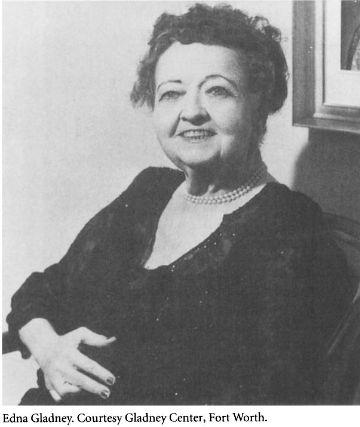 Edna Gladney would spend the rest of her life helping the children of others. (Photo from The Portable Handbook of Texas.)
Edna Gladney would spend the rest of her life helping the children of others. (Photo from The Portable Handbook of Texas.)
Some background: In the midnineteenth century East Coast cities such as Philadelphia and New York were inundated with orphans and abandoned children. Beginning in 1854 so-called orphan trains carried such children from the East to the Midwest and South, where they were placed with adoptive families. Between 1854 and 1929 orphan trains relocated almost 200,000 children.
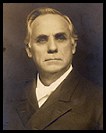
 In 1887 the Texas & Pacific railroad brought the first orphan train into Fort Worth. Isaac Zachary Taylor Morris, a Methodist preacher, and his wife Belle began taking in orphan train children—as many as fourteen at a time—and finding adoptive families for them. The Morrises’ work evolved into the Texas Children’s Home and Aid Society. It was organized in 1896 and chartered in 1904.
In 1887 the Texas & Pacific railroad brought the first orphan train into Fort Worth. Isaac Zachary Taylor Morris, a Methodist preacher, and his wife Belle began taking in orphan train children—as many as fourteen at a time—and finding adoptive families for them. The Morrises’ work evolved into the Texas Children’s Home and Aid Society. It was organized in 1896 and chartered in 1904.

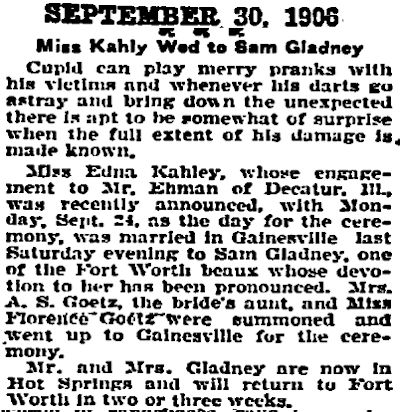 In 1903 Edna Kahly moved to Fort Worth to live with an aunt and uncle.
In 1903 Edna Kahly moved to Fort Worth to live with an aunt and uncle.
The year 1906 brought two important events:
(1) The Texas Children’s Home and Aid Society bought a house on Avenue H at Vaughn Boulevard in Poly to accommodate children until they were placed into homes.
(2) Edna Kahly broke her engagement to Mr. Ehman and instead married Sam Gladney, “one of the Fort Worth beaux whose devotion to her has been pronounced.”
 Sam Gladney was manager of the Medlin flour mill.
Sam Gladney was manager of the Medlin flour mill.
 In 1910 Edna joined the board of Texas Children’s Home and Aid Society.
In 1910 Edna joined the board of Texas Children’s Home and Aid Society.
But three years later the Gladneys moved to Sherman when Sam bought the Sherman Mill and Grain Company and renamed it “Gladney Milling Company.”
In Sherman Edna continued her charitable work. She and Sam became foster parents “to every lonely waif in Sherman, the Star-Telegram wrote. But Edna was not a stay-at-home do-gooder. She founded the Sherman Nursery and Kindergarten for Working Women; she joined the Sherman Civic League and inspected local meat markets and public restrooms for cleanliness; to finance her charitable work, she collected change in milk bottles that were placed in stores around Sherman.
On one of her sanitation inspections, Gladney found that the Grayson County poor farm was (1) unsanitary and (2) little more than a dumping ground for the unwanted, including unwanted children. You guessed it: Edna led a brigade of women who personally cleaned and whitewashed the poor farm. Then she arranged to have the children moved to the Texas Children’s Home and Aid Society in Fort Worth.
 Sam and Edna moved back to Fort Worth in 1918. Sam worked for various mills, and Edna continued her work for the Texas Children’s Home and Aid Society.
Sam and Edna moved back to Fort Worth in 1918. Sam worked for various mills, and Edna continued her work for the Texas Children’s Home and Aid Society.
 In 1927 Edna was named superintendent of the society. She planned to stay in the position for only a year, mainly as a fundraiser. She would overshoot her deadline by thirty-two years.
In 1927 Edna was named superintendent of the society. She planned to stay in the position for only a year, mainly as a fundraiser. She would overshoot her deadline by thirty-two years.
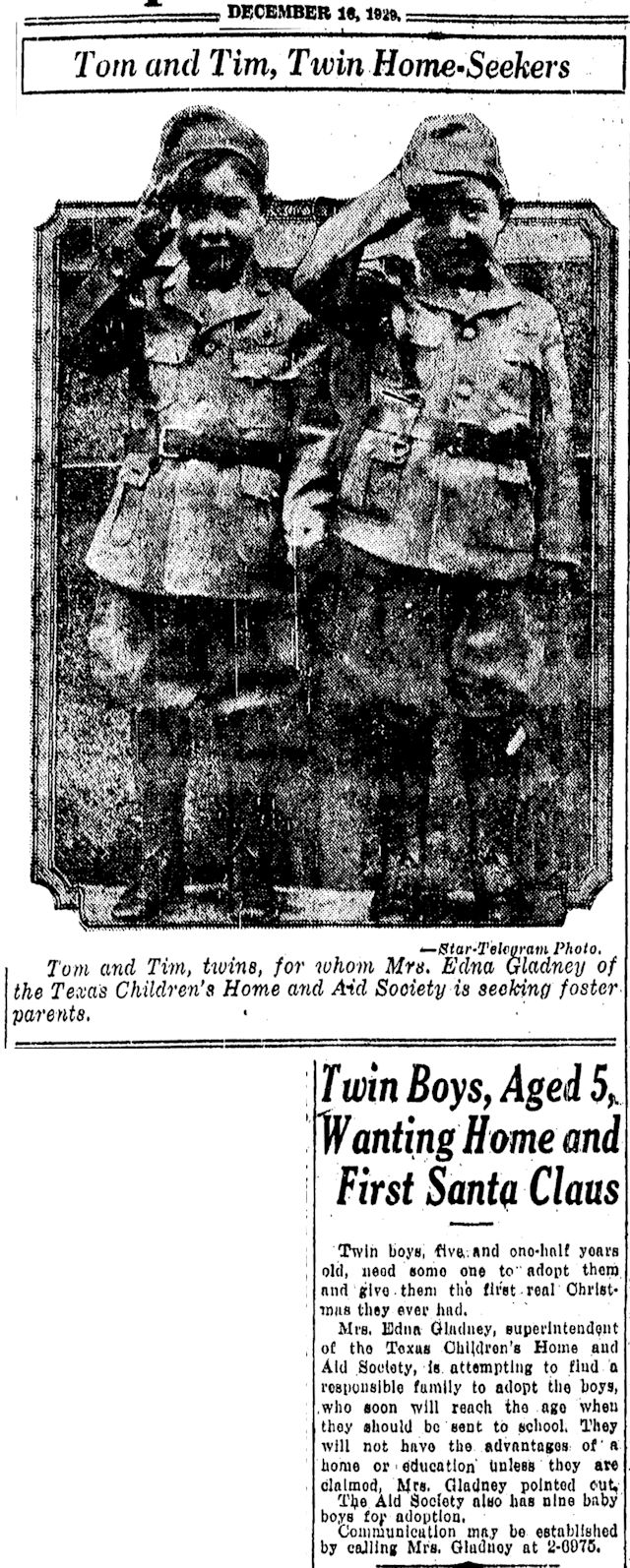 After the Star-Telegram printed this story at Christmas 1929, how many minutes do you think passed before Edna Gladney’s phone began to ring?
After the Star-Telegram printed this story at Christmas 1929, how many minutes do you think passed before Edna Gladney’s phone began to ring?
Under her leadership the society would begin to place more emphasis on helping unwed mothers and their babies. In 1936 Gladney lobbied the Texas legislature for passage of a bill that made the state the first in the Southwest to remove the label “illegitimate” from birth records. Her argument to the legislature: “There are no illegitimate children, only illegitimate parents.”
Four years later Ralph Wheelwright and his wife adopted a baby girl from Mrs. Gladney. Ralph Wheelwright was a publicist for Metro-Goldwyn-Mayer studios. He envisioned a movie in the inspiring work being done by Edna Gladney. He pitched the story to Louis Mayer, head of MGM.
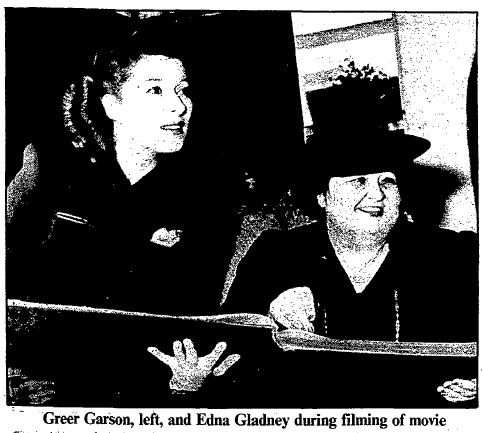
 On July 18, 1941 Blossoms in the Dust, starring Greer Garson and Walter Pidgeon, opened at the Worth Theater. (At the same night, Fort Worth’s first drive-in theater, the Bowie Boulevard, opened.)
On July 18, 1941 Blossoms in the Dust, starring Greer Garson and Walter Pidgeon, opened at the Worth Theater. (At the same night, Fort Worth’s first drive-in theater, the Bowie Boulevard, opened.)
(After Greer Garson died in 1996, her charitable foundation donated $500,000 to the Gladney Fund.)
The good works of Edna Gladney continued to be recognized. In 1953 she appeared on the TV program This Is Your Life.
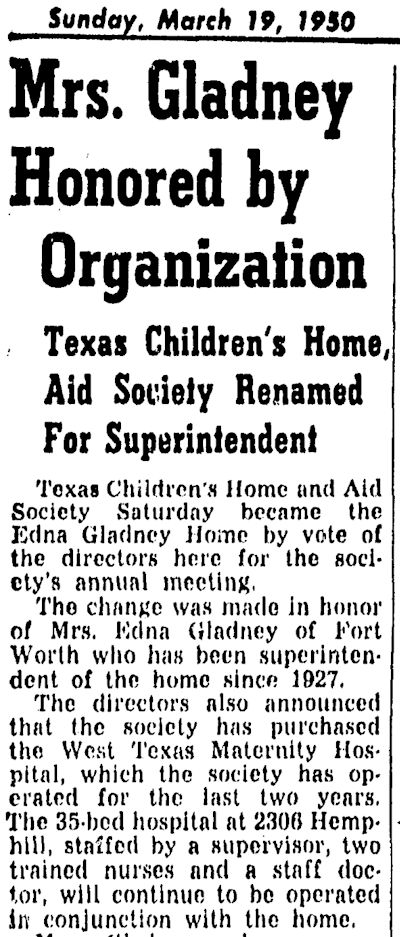
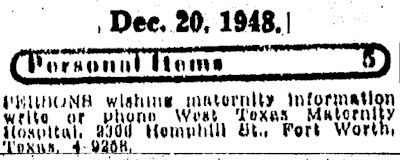 The year 1950 brought two more important events: (1) In recognition of her service, Texas Children’s Home and Aid Society was renamed the “Edna Gladney Home.” (2) The society bought the thirty-five-bed West Texas Maternity Hospital at 2300 Hemphill Street, which had opened about 1935. The Edna Gladney Home at the time was located at 1315 West El Paso on Quality Hill.
The year 1950 brought two more important events: (1) In recognition of her service, Texas Children’s Home and Aid Society was renamed the “Edna Gladney Home.” (2) The society bought the thirty-five-bed West Texas Maternity Hospital at 2300 Hemphill Street, which had opened about 1935. The Edna Gladney Home at the time was located at 1315 West El Paso on Quality Hill.
The home continued to expand its Hemphill campus into the 1980s. It eventually included the hospital, three dormitories, recreation hall, dining hall, offices, nursery, chapel, swimming pool, and miniature golf course. In addition to adoption services, the home provided education for middle school and high school students and a GED preparation and testing program.
The home could accommodate 150 mothers.
By 1951 Edna Gladney was back in Austin to fight for the rights of adopted children. She convinced lawmakers that adopted children should have the same inheritance rights as biological children and that they should be legally adopted rather than placed in long-term guardianship.
Because of her tenacity, Edna became known as “that Gladney woman” to members of the Texas legislature.
In recognition of her advocacy, in 1954, after more than forty years of helping children, “that Gladney woman” was profiled by Woman’s Home Companion in a feature entitled “I Gave Away 10,000 Babies.”

 The Edna Gladney Home expanded beyond the 2300 block of Hemphill. The Carnes Court apartments at 2100 Hemphill were built in 1918. Alva R. Carnes was a traveling salesman. In 1960 the apartment complex became part of the Edna Gladney campus. The home added an auditorium and a cafeteria.
The Edna Gladney Home expanded beyond the 2300 block of Hemphill. The Carnes Court apartments at 2100 Hemphill were built in 1918. Alva R. Carnes was a traveling salesman. In 1960 the apartment complex became part of the Edna Gladney campus. The home added an auditorium and a cafeteria.
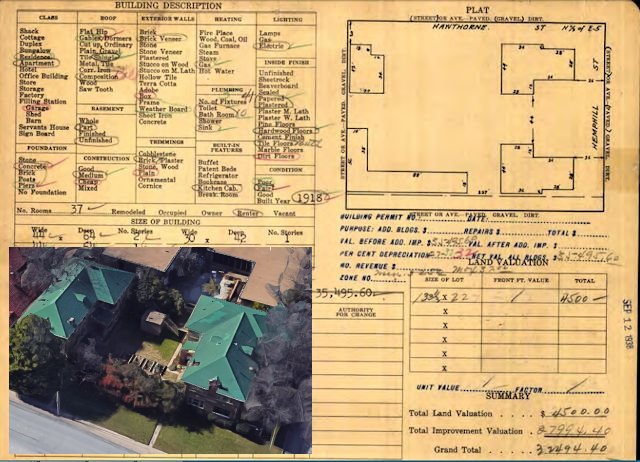 The apartments consisted of twin buildings with a courtyard between. Today the buildings house The Bastion restaurant and catering company.
The apartments consisted of twin buildings with a courtyard between. Today the buildings house The Bastion restaurant and catering company.

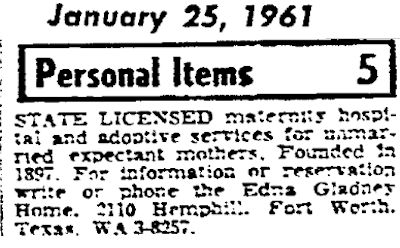 Also in 1960 the Edna Gladney Home bought the Tanner House (circa 1925) at 2110 Hemphill from Aggie Pate Jr. The house had been built for Jacob F. Tanner, whose family owned Tanner-Williams Printing Company. Today 2110 Hemphill is part of The Bastion complex.
Also in 1960 the Edna Gladney Home bought the Tanner House (circa 1925) at 2110 Hemphill from Aggie Pate Jr. The house had been built for Jacob F. Tanner, whose family owned Tanner-Williams Printing Company. Today 2110 Hemphill is part of The Bastion complex.
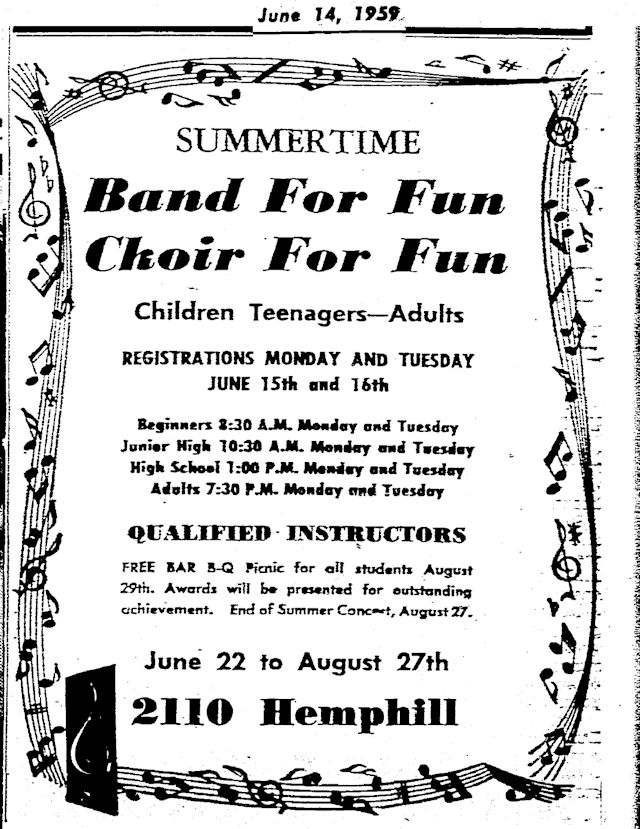 In 1959 a music studio had occupied the house.
In 1959 a music studio had occupied the house.
 Edna Gladney died in 1961.
Edna Gladney died in 1961.
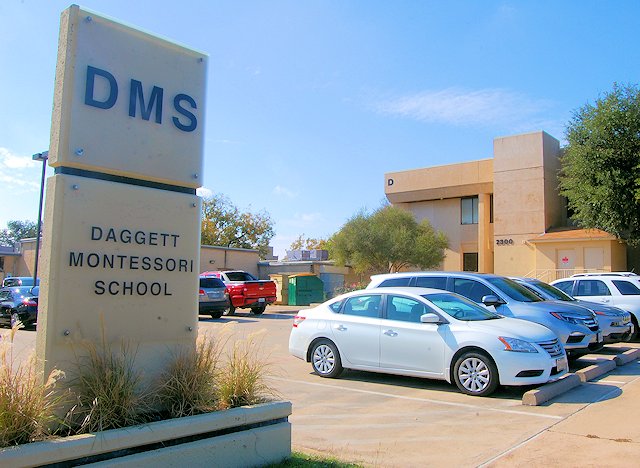 In 2001 the Gladney campus at 2300 Hemphill was renovated and expanded to house the school district’s Daggett Montessori School.
In 2001 the Gladney campus at 2300 Hemphill was renovated and expanded to house the school district’s Daggett Montessori School.
In 2002 the Edna Gladney Home, now known as “Gladney Center for Adoption,” moved to its new campus on John Ryan Drive in southwest Fort Worth.
Of course, the Gladney Center for Adoption has continued its mission in the sixty years since Gladney died. According to the center’s website, the number of children placed is now thirty thousand, the number of birth mothers served, thirty-seven thousand.
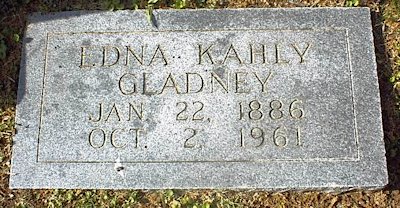
Edna Gladney, the childless woman who “gave away 10,000 babies,” is buried at Rose Hill Cemetery.
Other Cowtown benefactors of orphans:
Lena Pope
Belle Burchill
Belle and I. Z. T. Morris and the orphan trains
Masonic Home






Thank you for this wonderful compilation of articles. I was one of Edna’s 10,000 babies and I am most grateful to her for providing a safe harbor for my birthmother in her time of need after rape and for providing me with wonderful parents who were unable to have children of their own. By a miracle I was able to know my birthmother and she had nothing but praise for the Edna Gladney Home and how kindly she was treated. They went by fake names not as part of an attempt to brainwash as noted in an earlier comment, but rather to maintain privacy. Many like my birthmother came in secrecy and desired to resume their lives without any added stigma forced upon them by the culture of the 1950s. Giving up their babies was traumatic enough. I am so thankful for my birthmother’s courage and sacrifice, and I take great pride in the fact that this amazing strong crusader, Edna Gladney, personally placed me in my adoptive mother’s arms.
Thank you for this article. I will save it with the others I have. I am Edna Gladney’s great Niece. Edna Gladney’s sister, Dorothy Kahly Dumas, was my grandmother.
wedded mothers birthed children at the West Texas Maternity Hospital also.
I was born at the Edna Gladney home in 1940 and I am so thankful for Edna Gladney. Had I been conceived in this day and age, I probably would not ever have been born. I thank my birth mother for giving life and for giving me a wonderful Mom and Dad! She made a wonderful decision which truly blessed my life and I am forever grateful.
My comments are not made to denigrate Mrs. Gladney personally; they are a reflection of the times when girls were shamed, humiliated, and made to feel unworthy for being unmarried and pregnant. Most birth moms who were at the maternity homes back in the 1950-early 1970s don’t have rosy memories. Our time there was geared solely towards relinquishing our babies for adoption. There was no other option. It was a polite form of brainwashing. We were given fake names, our mail was censured, and we were told “forget this ever happened”. We were not allowed to even see our babies until they were 5 days old…and then for 15 minutes. There was no follow-up counseling. We felt like cogs trapped in the machinery. We were taught to lie. There is now much documented evidence on the lifelong trauma birth mothers faced due to society’s treatment of us. If you dispute my comments I suggest you read “The Girls Who Went Away” by Ann Fessler.
I was blessed to be a recipient by the Edna Gladney Adoption Center many, many years ago. I speak blessings upon this adoption center in JESUS NAME.
As an adoptive child from El Paso, Texas in the mid-1950’s, I know the shame & stigma that goes along with being adopted, people’s inability to understand it is not the child’s fault they are in the situation they are in, and the constant wondering who am I really, and more importantly, what have I inherited as far as problems/diseases that I could pass on to my own children. In my personal experience, Lynch Syndrome, diabetes, debilitating arthritis, depression, just to name a few. One doctor called me a melting pot of every bad disorder there is. But without people like Mrs. Gladney, Lena Pope, etc., children that were born out of wedlock got a second chance at life! And, people who can’t conceive have a second chance at parenthood. Thank God there were pioneers like Mrs. Gladney to change the stigmatization of adoption, the rules, the laws, and the lives of tens of thousands of human beings lives!
I worked as a student in training to become an LVN at All Saints Hospital and graduated from there in 1966. At that time the Edna Gladney home had their own area of the hospital not open to the public. There was labor and delivery, post partum and, of course newborn nursery, It was bit open to the public as many of the mothers would be placing their babies up for adoption. They were given opportunity to see their babies once more before the adoptive parents would get their babies. One little baby stands out in my memory, a little black baby girl. She was not a fan of her daily morning bact and would turn a very pretty pink under her beautiful brown skin. On this particular day I was to take the baby down the hall for one last visit with her biological mother. I remember being so surprised that her mother was very dark, but her child was not, and also she was quite tall. And here was this plump little darling with every curl on her head a perfect ringlet. I never forgot either one
Thank you for this personal recollection, Linda Lou.
Praise God for people like her. She made a difference to so many. She fought for the lives of the unwanted. We can all look to her as an example of love. Thanks for wonderful story! Bw
Today, there are places in our great nation where that same tubal pregnancy of yesteryear would simply be allowed to kill her; as there is only one treatment.
I am in no mood for any article or story that confers any importance to the condition of women being ‘ unwed’or seems to congratulate our society for not shipping a surplus of unwanted children to places where they cannot cause embarrassment.
This choice of story is incredibly insensitive.
I just want to set the FACTS straight here. A tubal (ectopic) pregnancy is a medical emergency!! Stop spreading lies about abortion . Please people do some research, just don’t accept everything some people tell you as the truth. Stop throwing hissy fits and educate yourself!!
Thank you.
Thanks for the great article! Will save for sure!
Thank you, Mrs. Younger.
God Bless Edna Gladney!